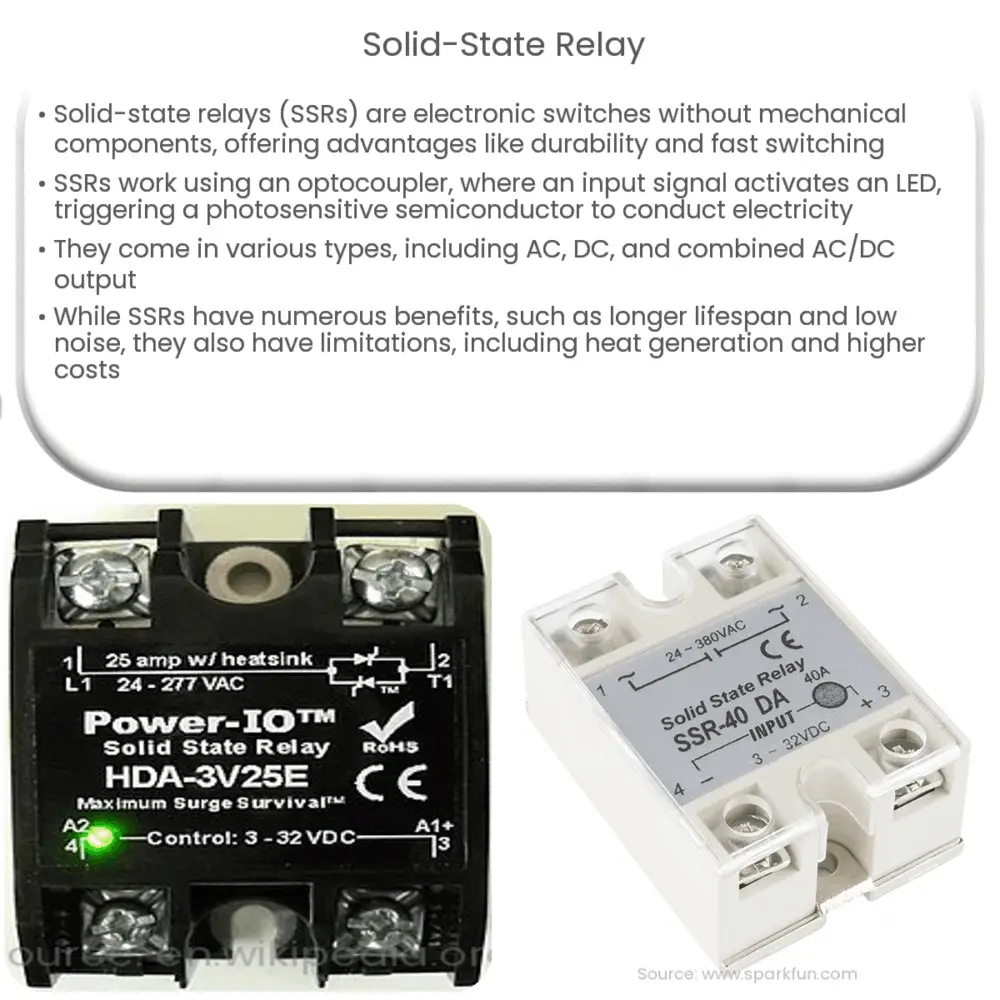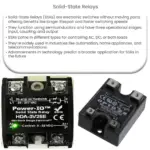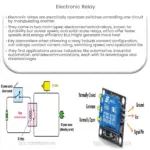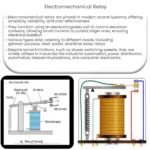A solid-state relay (SSR) is an electronic switch that controls electrical loads with no moving parts, offering fast, precise, and durable performance.

Solid-State Relay: A Comprehensive Guide
Introduction
Solid-state relays (SSRs) are an essential component in the world of electronics and electrical engineering. They are used in various applications, ranging from industrial automation to household appliances. This article will provide a comprehensive overview of solid-state relays, their working principle, types, advantages, and limitations.
What is a Solid-State Relay?
A solid-state relay is an electronic switching device that controls the flow of electrical power between two terminals without the use of any mechanical components. It acts as an alternative to electromechanical relays (EMRs) and uses semiconductors to perform the switching function. SSRs have become increasingly popular due to their durability, reliability, and fast switching capabilities.
Working Principle of a Solid-State Relay
The basic working principle of an SSR involves the use of an input control signal to trigger an output load. When a small control voltage is applied to the input side of the SSR, it activates an optocoupler or an opto-isolator. The optocoupler consists of a light-emitting diode (LED) and a photosensitive semiconductor, which are electrically isolated from each other.
Upon receiving the input control signal, the LED emits light, which falls on the photosensitive semiconductor. This causes the semiconductor to conduct, effectively closing the circuit between the load and the power source. When the control signal is removed, the LED stops emitting light, and the semiconductor returns to its non-conductive state, opening the circuit and disconnecting the load from the power source.
Types of Solid-State Relays
There are various types of solid-state relays available in the market, based on their input control signals and output load capabilities. Some of the most common types of SSRs include:
- AC Output SSR: These SSRs are designed to control alternating current (AC) loads. They typically use a triac or a thyristor as the output switching device.
- DC Output SSR: These SSRs are used for controlling direct current (DC) loads. They generally use a transistor, such as a MOSFET, as the output switching device.
- AC/DC Output SSR: These SSRs can control both AC and DC loads, making them suitable for a wide range of applications.
- Input/Output SSR: These SSRs have both input and output stages within the same device, enabling them to accept a wide range of input control signals and drive various types of loads.
Advantages of Solid-State Relays
Solid-state relays offer numerous benefits over their electromechanical counterparts, including:
- Longer lifespan: SSRs have no moving parts, which eliminates mechanical wear and tear, leading to a longer service life.
- Fast switching: SSRs can switch on and off in microseconds, enabling rapid and precise control of electrical loads.
- Low noise: The absence of mechanical contacts means that SSRs generate minimal audible noise during operation.
- Shock and vibration resistance: Due to their solid-state construction, SSRs are more resistant to mechanical shocks and vibrations than electromechanical relays.
- Optical isolation: The use of optocouplers in SSRs provides electrical isolation between input and output circuits, reducing the risk of electrical interference and damage to sensitive components.
Limitations of Solid-State Relays
Despite their numerous advantages, solid-state relays also have some limitations:
- Heat generation: SSRs generate heat during operation, which can affect their performance and reliability if not properly managed with adequate heat sinks or cooling systems.
- Higher cost: SSRs are generally more expensive than electromechanical relays, especially for high-power applications.
- Leakage current: Unlike electromechanical relays, SSRs may have a small amount of leakage current even when they are in the off state, which can be problematic in some applications.
- Lower maximum current rating: SSRs often have lower maximum current ratings compared to electromechanical relays, which can limit their suitability for high-current applications.
Applications of Solid-State Relays
Solid-state relays are used in a wide range of applications, including:
- Industrial automation: SSRs are used in process control systems, programmable logic controllers (PLCs), and other automation equipment for precise control of motors, pumps, valves, and other electrical loads.
- Lighting control: SSRs are used in lighting systems to control the intensity and duration of illumination, as well as for dimming and color-changing applications.
- Home appliances: SSRs are found in devices such as washing machines, air conditioners, and microwave ovens for accurate control of heating elements, motors, and other electrical components.
- Renewable energy systems: SSRs are used in solar and wind power systems to manage the flow of electrical energy between storage batteries, inverters, and the grid.
Conclusion
Solid-state relays are versatile and reliable electronic devices that have revolutionized the way electrical loads are controlled in a variety of applications. With their numerous advantages, including long lifespan, fast switching, and low noise, SSRs have become a preferred choice over electromechanical relays in many instances. However, it is essential to consider their limitations, such as heat generation and higher cost, when selecting the appropriate relay for a specific application.




